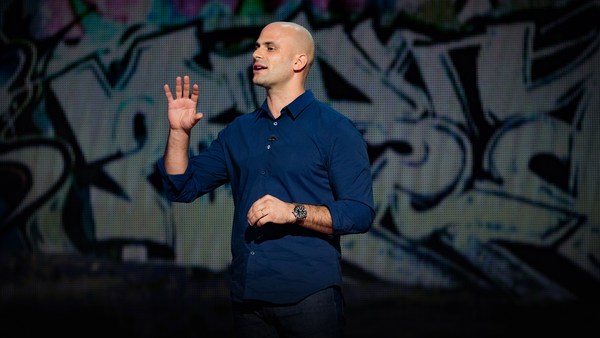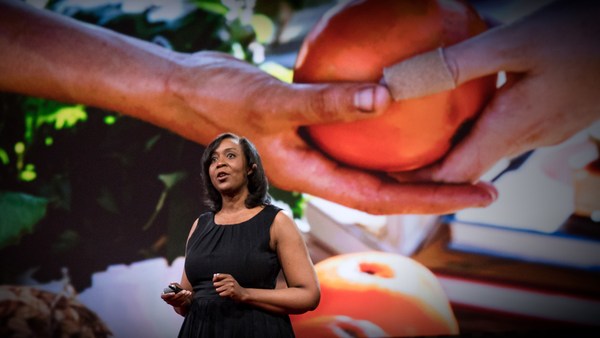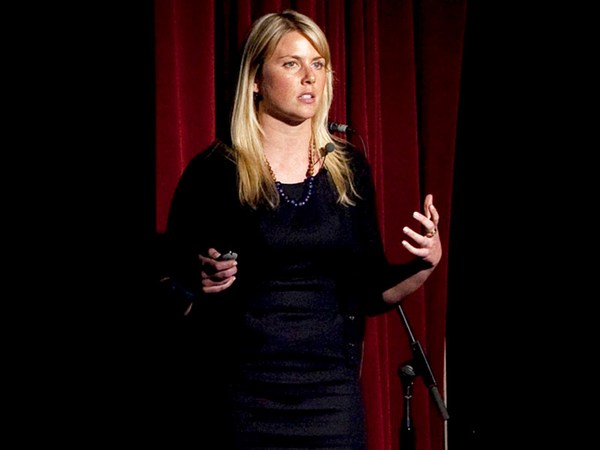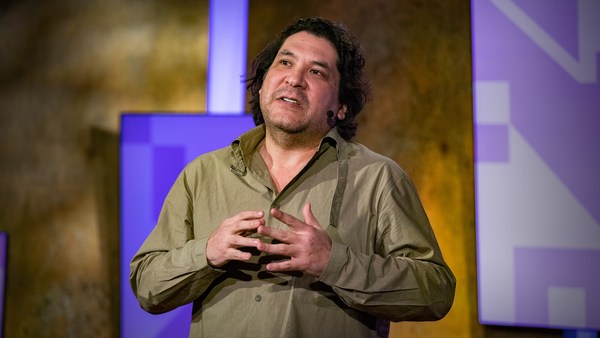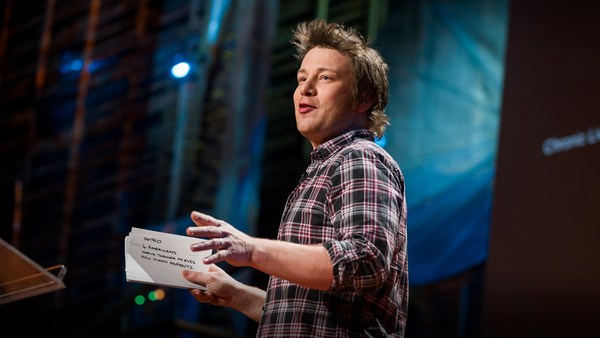All right, let's get ready for the worst TED Talk ever.
(Laughter)
I mean it. We prepared 30 minutes ago. I want to have it clear -- I love to be here with you all, but I wanted to be here not to tell my story but to tell the story of the amazing people of Puerto Rico that came together to feed the people of Puerto Rico.
My name is José Andrés, and you know I love to feed the few, but even more, I love to feed the many. Here, right after the hurricane, like we'd done many times before after an earthquake in Haiti or Sandy or others, I had this sense of urgency to be there and to try to feed one person, and always, you have crazy friends that want to join you in those impossible endeavors. I'm always surrounded by amazing friends that only help me to be better. Nate came next to me.
This was a Monday, and this is what we found. The destruction you saw on TV, one more hurricane, but this destruction was real. More than 95 percent of the electricity in the island was gone. Every single electric post was gone. All the cell towers were gone. You couldn't communicate with anybody. You couldn't find anybody the moment you moved away from San Juan. Even in San Juan, we had issues trying to use our cell phones. And what I found was that the island was hungry, and the people didn't have money, because ATMs were not working, or their cards, which are electronic, for food stamps, they couldn't use it in their supermarkets, or there was no food or gas or clean water to cook. The need and the urgency of now was real, and I was just able to get into a meeting at FEMA, where many of the main NGO partners were having a conversation about how to feed the island in the weeks to come, but the urgency was right now, in this minute, in this second, and we almost had three million people that needed to be fed.
So we began doing what we do best. We went to see the sources of food, and I was able to see that the private industry actually was ready and prepared and thriving, but somebody at FEMA was not able even to be aware of that. And what we did was use fine kitchens. José Enrique, one of my favorite men in the whole world, one of the great restaurants in San Juan, where before landing, I began calling all the chefs of Puerto Rico, and everybody was like, "Let's not plan, let's not meet, let's start cooking."
(Laughter)
And that's what we did. We began feeding the people of Puerto Rico, on a Monday. On a Monday, we did a thousand meals, sancocho, an amazing stew with corn and yucca and pork. By Sunday, we were doing 25,000. By Sunday, we already didn't only use the restaurant, but we rented the parking lot right across. We began bringing food trucks, and a rice and chicken paella operation, and refrigerators, and volunteers began coming. Why? Because everybody wants to find a place to help, a place to do something.
This is how we began our first delivery. The hospitals -- nobody was feeding the nurses and the doctors, and we began feeding our first project, Hospital Carolina. All of a sudden, every single hospital was calling us. "We need food so we can feed our 24/7 employees taking care of the sick and the elderly and the people in need."
And then the place was too small. We were receiving orders. Every time we got one guest, one customer, we never stopped serving them, because we wanted to make sure that we were able to be stabilizing any place we were joining, any city, any hospital, any elderly home. Every time we made contact with them, we kept serving them food, day after day, so we needed to grow. We moved into the big coliseum. 25,000 meals became 50,000 meals, became, all of a sudden, the biggest restaurant in the world. We were making close to 70,000 meals a day from one location alone.
(Applause)
Volunteers began showing up by the hundreds. At one point, we got more than 7,000 volunteers that were at least one hour or more with us, at any given moment, more than 700 people at once. You saw that we began creating a movement, a movement that had a very simple idea everybody could rally behind: let's feed the hungry.
And we began making food that people could recognize, not things that come from a faraway place in plastic bags that you open and you cannot even smell.
(Laughter)
We began making the foods that people feel home. People in these moments, they had this urgency of feeling they are alive, that somebody cares. One meal at a time, it didn't only become something used to bring calories to their bodies, calories that they needed, but they needed something else. They wanted to make sure that you and you and you and you, that you were caring, that we were sending the message that we are with you. Give us time, we are trying to fix this. That's what we found every time we began joining the communities. Fresh fruit began coming, even when in FEMA, they were asking me, "José, how are you able to get the food?" Simple: by calling and paying and getting.
(Laughter)
(Applause)
We began feeding people in San Juan. Before you knew, we were feeding the 78 municipalities all across the island. We needed a plan. One kitchen alone was not going to feed the island. I went to FEMA. They kicked me out with eight armored guards and AK-47s. I told them, "I want 18 kitchens around the island." Guess what? Three days ago, we reached our 18th kitchen around Puerto Rico.
(Applause)
People began being fed. Volunteers kept showing up. We never had any system to deliver the food, people would tell me. Sure, we had the system. The entire island of Puerto Rico was the perfect delivery system. Anybody with a truck wanted to help. Anybody going from A to B was for us the way to be bringing hope and a plate and a whole meal to anybody. We began finding amazing systems to do these food trucks, 10 amazing food trucks. We began learning not to use the place that needed the food, but the number, the number of the apartment: Lolo, a 92-year-old veteran that was surrounded by water. We began giving not only hope to people, but knowing their names, checking day after day, making sure that those elderly people will never, ever again feel alone in a moment of disrepair.
And we began going to the deeper areas, places that all of a sudden, the bridges were broken, but we had to go, because it was easy to stay in San Juan. We had to go to those places that actually, they really needed us. And we kept going, and people kept waiting for us, because they knew that we will always show up, because we will never leave them alone.
(Applause)
The food trucks became our angels, and the food trucks kept sending hope, but we saw we needed more: Vieques and Culebra, two islands far away from the island -- somebody had to be feeding them. We didn't only bring food and make a hotel kitchen operation in Vieques and bring daily food to Culebra. We brought the first water purification system to the island of Vieques, where we could be filtering one gallon per minute. All of a sudden, big problems become very simple, low-hanging fruit solutions, only by doing, not planning and meeting in a very big building.
(Laughter)
And then we found creative ways. We needed helicopters. We asked. We got. We needed planes. We asked, we paid, and we got. We kept sending food to those places that really were in need. And the simple ideas just become powerful. Volunteers will go to the edges of the island. All of a sudden, it was a movement. The teams of World Central Kitchen will be received with prayers, with songs, with claps, with hugs, with smiles. We were able to connect in so many corners. When I tell you that even the National Guard began calling us because our national poor guy's guards, big heroes in a moment of chaos, they couldn't get a simple humble plate of hot food.
And partnerships show up. Mercy Corps, HSI from Homeland Security, partnerships that they didn't happen calling the top. They happened in the hotel room, in the middle of the street, in the middle of the mountains. We saw that by working together, we can even reach more people. Partnerships that happen by logic, and the urgency of now is put to the service of the people. When we have emergency relief organizations, we cannot be planning about how to give aid a month from now. We have to be ready to start giving help the second after something happens.
And children were fed, and all of a sudden, the island, while still in a very special moment where everything is fragile, we saw that an NGO like ours -- we didn't want to break the private sector -- that already, small restaurants were being opened, that somehow, normalcy, whatever normalcy means today in Puerto Rico, was happening. We began trying to be sending the message: we need to start moving away from the places that are already stabilized and keep concentrating in the areas that really need help.
(Video): People of Puerto Rico, two million meals!
José Andrés OK, let me translate this to you.
(Laughter)
Almost 28 days later, more than 10 food trucks, more than 7,000 volunteers, 18 kitchens ... we served more than two million meals.
(Applause)
(Applause ends)
And you guys coming here to TED, you should be proud, because we know many of you, you are part of the change. But the change is only going to happen if after we leave this amazing conference, we put the amazing ideas and inspiration that we get, and we believe that nothing is impossible, and we put our know-how to the service of those in need.
I arrived to an island trying to feed a few people, and I saw a big problem, and all of a sudden, the people of Puerto Rico saw the same problem as me, and only we did one thing: we began cooking. And so the people of Puerto Rico and the chefs of Puerto Rico, in a moment of disrepair, began bringing hope, not by meeting, not by planning, but with only one simple idea: let's start cooking and let's start feeding the people of Puerto Rico.
Thank you.
(Applause)
Dave Troy: Go back out.
(Laughter)
DT: The public loves you.
(Applause)
Nate Mook: A couple of quick questions, because I think some folks would be interested to hear. So as you said, you came the first time, got on the ground, went to the government command center, started to have some meetings with people, and they weren't very receptive.
José Andrés: This is great. This is how good my talk was.
(Laughter)
It's the first talk with a follow-up in the history of TED. I feel so good.
(Laughter)
NM: So tell us why, what were some of the challenges, and then when you noticed, they started coming to you to ask you.
JA: We cannot be asking everything from Red Cross or Salvation Army. But the idea is, I donated before to those organizations, and they are the big organizations, and maybe the problem is that we're expecting too much from them. It's not like they didn't do what they were supposed to do. It's that the perception is that that's what they do. But all of a sudden, you cannot get into a moment like this and wash your hands, and you say somebody else is going to be picking it up. We had a simple problem that had a very simple solution. This was not a faraway country or the Green Zone in Baghdad. This was American soil, a beautiful place called Puerto Rico, with hundreds, thousands of restaurants and people willing to help, but all of a sudden, we had people hungry, and we didn't have a plan how to feed them in the short term.
So yes, FEMA, to a degree, was thinking about how to feed the people. Red Cross didn't have the right answers, because Southern Baptist Church, the biggest food organization in America, my heroes, they were never called to Puerto Rico. When you see the Red Cross delivering food in America after a hurricane, it's Southern Baptist Church doing it. We didn't have that in Puerto Rico. Salvation Army came and asked me for 420 meals on a Wednesday rainy night for a local elderly shop. I love to help the Salvation Army, but in my world, they are the ones who are supposed to be helping us to answer those calls of help. Thursday morning is when I wake up super worried that actually we didn't have the plan to feed the island. And some people will say maybe you are making the problem bigger than it was.
Well, we had hundreds and hundreds and hundreds and hundreds of organizations knocking on our door, asking for a tray of food, so if that's not proof that the need was real ... We cannot be feeding people in America anymore with MREs or something like you open and, you know, I was giving to this little cat a little bit of those same foods --
(Laughter)
and then I gave them the chicken and rice we made, and they went for the chicken and rice.
(Laughter)
(Applause)
They don't even eat that themselves. We can feed humanity for a day or two or five, but those MREs cost, like, 12, 14, 15, 20 dollars to the American taxpayer. It's OK for certain moments, during battle, but not to be feeding Americans for weeks and weeks and weeks, when actually, you can be hiring the local private business community to do the same job better, creating local jobs, helping the local economy to come back, and in the process making sure that everything was going to go back as normal as quick as possible. That's where we began cooking. You were there with me, and that's why we spent every single dollar we had in our credit cards. If AmEx is listening to this, please, a discount would be appreciated.
(Laughter)
Or Visa.
NM: So what's the situation now? You know, it's been a month. You said there's been some improvements in San Juan and focus on the areas outside, but obviously there are still major challenges, and what's next?
JA: There are. So what's next is we slowly began going down after, more or less, FEMA let us know that they thought they had everything under control and we were no longer needed, but you only believe everything so much. We moved from the big place you saw, 60,000 meals a day, to another one, as big, but more strategically located, also cheaper, where we are going to be making 20-25,000 meals a day, and then we are leaving four, five, six kitchens strategically located around the island, very high up in the mountains, in the poor areas. We got a lot of data. We know who is using SNAPs, who is using food stamps, the cards. We know who has them and we know who is using them. So in the parts of the island where nobody is using them, those are the parts of the island where we are going to be focusing our efforts. So it's amazing how sometimes simple data can give you a clue of who are the people in need. So we went to a town called Morovis. Beautiful. The best chicken restaurant in the history of mankind. You should all travel to Morovis.
DT: Sounds good.
JA: So I saw the chicken. We were bringing sandwiches. I stopped. I was with these Homeland Security officers. We ate the chicken. I left to drop these sandwiches in this other place called San Lorenzo. San Lorenzo was critical, because the bridge was broken, and so it was an island inside the island, a little community surrounded by water. Everybody told us, "It's a disaster down there." We dropped the sandwiches. I went back to Morovis, and I thought, you know, if it's a disaster, sandwiches is not enough. I brought 120 chickens, with yucca and with rice, and we went back to that broken bridge, we crossed the river, water up to everywhere. We arrived with the 120 chickens, we dropped the food, and the community were very thankful, but they told us, "We're OK, we don't need more food. We have gas, we have money, we have good food and our water is clean. Take care of the other communities around us that are in more need."
You see, communication is key. In these scenarios, we can be relying on fake news or we can be having the real information that we can make smart decisions to really take care of the true issues. That's what we are doing.
(Applause)
NM: It was an amazing operation, and to witness it firsthand and to play a small role --
JA: You made it happen.
NM: At its peak, I think you were up to about 150,000 meals per day, across the island, which is pretty incredible. And I think, at the same time, really sort of setting a model for how this can be done, hopefully, moving forward. I mean, I think that's one of the big learnings out of this --
DT: This is possible. You know, people can replicate this.
JA: But I'm going to stop coming to watch TED Talks, because you've got ideas that anything can happen.
(Laughter)
And then my wife told me, "Man, you told me you were going to cook a thousand meals a day. I cannot leave you alone for a day."
(Laughter)
But I hope that World Central Kitchen -- you know, one thing we did I didn't say: I picked up the phone and I began calling people, people that I thought had expertise that could help us. So I picked up the phone and I called a company called Bon Appétit, Fedele. Bon Appétit's one of the big catering companies. They do food for Google and for arenas. They're out of California. They belong to a bigger group called Compass. And I told them, "You know what? I need cooks, and I need cooks that can do volume and that can do good, quality volume." In less than 24 hours, I began getting people and chefs. At one point, we got 16 of the best chefs that America can offer. You see, America is an amazing heart country that always is sending their best. What we've been learning over the years is that those chefs of America are going to be playing a role in how we are going to be feeding America and maybe other parts of the world in times of need. What we need to start is bringing the right expertise where the expertise is needed. Sometimes I have a feeling, like with FEMA, we are bringing the wrong expertise in the areas that it's not even needed. The people of FEMA are great people. The men and women are smart, they are prepared, but they live under this amazing hierarchy pyramidal organizational chart that everybody falls out of their own weight. We need to be empowering people to be successful. What we did was a flatter organizational chart where everybody was owning the situation and we all made quick decisions to solve the problems on the spot.
(Applause)
DT: Absolutely.
(Applause)
Another round of applause for José Andrés.
(Applause) (Cheering)

